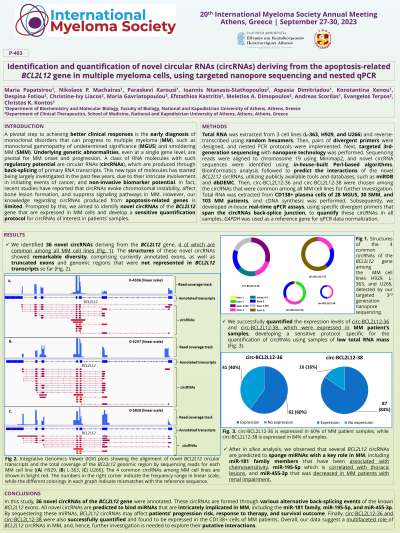Myeloma Microenvironment and immune profiling
Poster Session 3
P-403: Identification and quantification of novel circular RNAs (circRNAs) deriving from the apoptosis-related BCL2L12 gene in multiple myeloma cells, using targeted nanopore sequencing and nested qPCR
Friday, September 29, 2023
1:15 PM - 2:15 PM EEST


Maria Papatsirou, BSc (she/her/hers)
Scientific associate
National and Kapodistrian University of Athens
Athens, Attiki, Greece
Introduction: A pivotal step to achieving better clinical responses is the early diagnosis of monoclonal disorders that can progress to multiple myeloma (MM), such as monoclonal gammopathy of undetermined significance (MGUS) and smoldering MM (SMM). A class of RNA molecules with regulatory potential in MM are circular RNAs (circRNAs). However, our knowledge regarding circRNAs produced from apoptosis-related genes is limited. Prompted by this, we aimed to identify novel circRNAs of the BCL2L12 gene that are expressed in MM cells and develop a sensitive quantification protocol for circRNAs of interest in patients’ samples.
Methods: Total RNA was extracted from 3 cell lines (L-363, H929, and U266) and reverse-transcribed using random hexamers. Then, pairs of divergent primers were designed, and nested PCR protocols were implemented. Next, targeted 3rd-generation sequencing with nanopore technology was performed. Νovel circRNA sequences were identified using in-house–built Perl-based algorithms. Bioinformatics analysis followed to predict the interactions of the novel BCL2L12 circRNAs, utilizing publicly available tools and databases, such as miRDB and dbDEMC. Then, circ-BCL2L12-36 and circ-BCL2L12-38 were chosen among the circRNAs that were common among all MM cell lines for further investigation. Total RNA was extracted from CD138+ plasma cells of 28 MGUS, 30 SMM, and 103 MM patients, and cDNA synthesis was performed. Subsequently, we developed in-house real-time qPCR assays, using specific divergent primers that span the circRNAs back-splice junction, to quantify these circRNAs in all samples. GAPDH was used as a reference gene for qPCR data normalization.
Results: We identified 36 novel circRNAs deriving from the BCL2L12 gene, 4 of which are common among all MM cell lines. The structures of these novel circRNAs showed remarkable diversity, comprising currently annotated exons, as well as truncated exons and genomic regions that were not represented in BCL2L12 transcripts so far. Moreover, several BCL2L12 circRNAs are predicted to sponge miRNAs with a key role in MM, including miR-181 family members that have been associated with chemosensitivity, miR-195-5p which is correlated with thoracic lesions, and miR-455-3p that was decreased in MM patients with renal impairment. Furthermore, circ-BCL2L12-36 is expressed in 60% of patient samples, while circ-BCL2L12-38 is expressed in 84.5% of samples.
Conclusions: In this study, 36 novel circRNAs of the BCL2L12 gene were annotated. These circRNAs are formed through various alternative back-splicing events of the known BCL2L12 exons. All novel circRNAs are predicted to bind miRNAs that are intricately implicated in MM. By sequestering these miRNAs, BCL2L12 circRNAs may affect patients’ progression risk, response to therapy, and survival outcome. Finally, circ-BCL2L12-36 and circ-BCL2L12-38 were also successfully quantified and found to be expressed in the CD138+ cells of patients at different disease stages.
Methods: Total RNA was extracted from 3 cell lines (L-363, H929, and U266) and reverse-transcribed using random hexamers. Then, pairs of divergent primers were designed, and nested PCR protocols were implemented. Next, targeted 3rd-generation sequencing with nanopore technology was performed. Νovel circRNA sequences were identified using in-house–built Perl-based algorithms. Bioinformatics analysis followed to predict the interactions of the novel BCL2L12 circRNAs, utilizing publicly available tools and databases, such as miRDB and dbDEMC. Then, circ-BCL2L12-36 and circ-BCL2L12-38 were chosen among the circRNAs that were common among all MM cell lines for further investigation. Total RNA was extracted from CD138+ plasma cells of 28 MGUS, 30 SMM, and 103 MM patients, and cDNA synthesis was performed. Subsequently, we developed in-house real-time qPCR assays, using specific divergent primers that span the circRNAs back-splice junction, to quantify these circRNAs in all samples. GAPDH was used as a reference gene for qPCR data normalization.
Results: We identified 36 novel circRNAs deriving from the BCL2L12 gene, 4 of which are common among all MM cell lines. The structures of these novel circRNAs showed remarkable diversity, comprising currently annotated exons, as well as truncated exons and genomic regions that were not represented in BCL2L12 transcripts so far. Moreover, several BCL2L12 circRNAs are predicted to sponge miRNAs with a key role in MM, including miR-181 family members that have been associated with chemosensitivity, miR-195-5p which is correlated with thoracic lesions, and miR-455-3p that was decreased in MM patients with renal impairment. Furthermore, circ-BCL2L12-36 is expressed in 60% of patient samples, while circ-BCL2L12-38 is expressed in 84.5% of samples.
Conclusions: In this study, 36 novel circRNAs of the BCL2L12 gene were annotated. These circRNAs are formed through various alternative back-splicing events of the known BCL2L12 exons. All novel circRNAs are predicted to bind miRNAs that are intricately implicated in MM. By sequestering these miRNAs, BCL2L12 circRNAs may affect patients’ progression risk, response to therapy, and survival outcome. Finally, circ-BCL2L12-36 and circ-BCL2L12-38 were also successfully quantified and found to be expressed in the CD138+ cells of patients at different disease stages.
